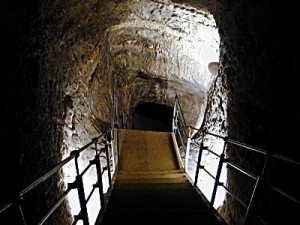Jerusalem’s Water Supply During Siege, Yigal Shiloh, Biblical Archaeology Review (7:4), Jul/Aug 1981.
 The Rediscovery of Warren’s Shaft
The Rediscovery of Warren’s Shaft
The earliest city of Jerusalem was located on a small, 10 to 15 acre, spur south of the Temple Mount and the wall enclosing the Old City. This ancient area is known today as the City of David and, sometimes, as the hill of Ophel. The original city of Jerusalem was established here because it is here that Jerusalem’s only fresh water source—the Gihon Spring—is located, and because the long, narrow hill is protected on three sides by deep valleys.
Around this spring—on the eastern side of the City of David in the Kidron Valley—the first settlement in the area developed during the Early Bronze Age (about 3100 B.C.). But very probably, there was settlement here even earlier, in the Chalcolithic Age (about 3500 B.C.). We have pottery evidence from both of these periods.
We know that during the late Iron Age (1000 B.C.-586 B.C.), the City of David was served by three interconnected water systems all emanating from the Gihon Spring.
The best known of these three water systems is Hezekiah’s Tunnel, so named because it was built by this Judean king in the late eighth century B.C. One of the reasons King Hezekiah dug the tunnel was to prepare for an expected siege by the Assyrian ruler Sennacherib, which occurred in about 701 B.C.
Read the rest of Jerusalem’s Water Supply During Siege in the online Biblical Archaeology Society Library.



